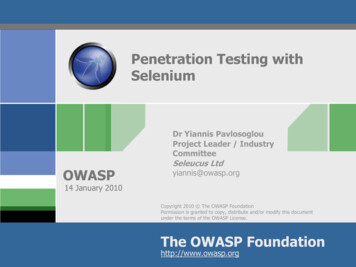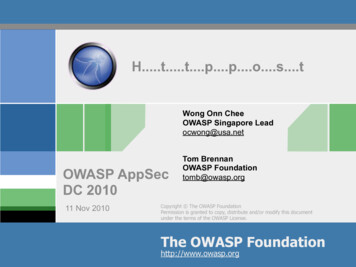
Transcription
H.t.t.p.p.o.s.tWong Onn CheeOWASP Singapore Leadocwong@usa.netOWASP AppSecDC 201011 Nov 2010Tom BrennanOWASP Foundationtomb@owasp.orgCopyright The OWASP FoundationPermission is granted to copy, distribute and/or modify this documentunder the terms of the OWASP License.The OWASP Foundationhttp://www.owasp.org
Agenda Introduction to Layer 7 DDOS attacks Different types of Layer 7 DDOS web attacks Analysis of HTTP POST DDOS attack DemoOWASP2
First, there was Layer 4 DDOS. Past DDOS attacks were mainly Layer 4 (TCP)attacks.OWASP3
Layer 4 DDOS attacks Reach bandwidth or connection limits ofhosts or networking equipment. Fortunately, current anti-DDOS solutions areeffective in handling Layer 4 DDOS attacks.OWASP4
Then, there were Layer 7 DDOS attacks Operates at the application protocol level(OSI Layer 7). Eg. HTTP(S), SMTP, FTP and etc.OWASP5
Effectiveness of Layer 7 DDOS attacks Legitimate TCP or UDP connections. Difficult todifferentiate from legitimate users higherobscurity. Requires lesser number of connections higher efficiency. Reach resource limits of services.Can deny services regardless of hardwarecapabilities of host higher lethality.OWASP6
Agenda Introduction to Layer 7 DDOS attacks Different types of Layer 7 DDOS web attacks Analysis of HTTP POST DDOS attack DemoOWASP7
Types of Layer 7 DDOS web attacks Excludes causes related to stupid or inefficientcodes. (Yes! You can DOS yourself) We will focus on protocol weaknesses of HTTPor HTTPS. HTTP GET Michal Zalewski, Adrian IlarionCiobanu, RSnake (Slowloris) HTTP POST Wong Onn CheeOWASP8
HTTP GET DDOS attack First highlighted by Michal Zalewski and AdrianIlarion Ciobanu in 30/0/threaded Popularized in 2009 by Rsnake with the freetool, Slowloris. Slowloris used time-delayed HTTP headers tohold on to HTTP connections and exhaust webserver threads or resources. Can evade Layer 4 DDOS protection systems.More info can be found -dos/OWASP9
HTTP GET DDOS attack Apache Foundation disagreed this is a bug andhad no plans to “fix it”. To AF, waiting for theHTTP headers to complete sending is a basicand inherent behavior of web servers. Microsoft IIS imposes a timeout for HTTPheaders to be sent. Any HTTP connection whichexceeds the headers timeout will be closed,hence rendering HTTP GET attacks ineffectiveagainst IIS web servers.OWASP10
Limitations of HTTP GET DDOS attack Does not work on IIS web servers or webservers with timeout limits for HTTP headers. Easily defensible using popular load balancers,such as F5 and Cisco, reverse proxies andcertain Apache modules, such as mod antiloris. Anti-DDOS systems may use “delayedbinding”/“TCP Splicing” to defend against HTTPGET attacks.OWASP11
Agenda Introduction to Layer 7 DDOS attacks Different types of Layer 7 DDOS web attacks Analysis of HTTP POST DDOS attack DemoOWASP12
HTTP POST DDOS attack First discovered in Sep 2009 by Wong OnnChee and his team. Escalated to Microsoft and AF in Q1 2010. Bothinterpreted this to be a protocol bug. Apache: “What you described is a known attribute (read: flaw) of theHTTP protocol over TCP/IP. The Apache HTTP project declines to treat thisexpected use-case as a vulnerability in the software.” MS: “While we recognize this is an issue, this issue does not meet ourbar for the release of a security update. We will continue to track this issueand the changes I mentioned above for release in a future service pack.”OWASP13
How HTTP POST DDOS attack works(HTTP/1.0) Uses HTTP POST requests, instead of HTTPGET which is used by Slowloris. “A POST request includes a message body inaddition to a URL used to specify information forthe action being performed. This body can useany encoding, but when webpages send POSTrequests from an HTML form element theInternet media type is "application/x-www-formurlencoded". (source: Wikipedia - “POST (HTTP)”)”OWASP14
How HTTP POST DDOS attack works(HTTP/1.0) (cont'd) The field “Content-Length” in the HTTP Headertells the web server how large the message bodyis, for e.g., “Content-Length 1000” The HTTP Header portion is complete and sentin full to the web server, hence bypassing IISinherent protection.OWASP15
How HTTP POST DDOS attack works(HTTP/1.0) (cont'd) For e.g., Content-Length 1000 (bytes) The HTTP message body is properly URLencoded, but . .is sent at, again for e.g., 1 byte per 110seconds. Multiply such connections by 20,000 and yourIIS web server will be DDOS. Most web servers can accept up to 2GB worth ofcontent in a single HTTP POST request.OWASP16
Sample code to simulate HTTP POST DDOSattack (HTTP/1.0)private String getRequestHeader() {String requestHeader "";requestHeader param.getMethod() " " param.getUrl() " HTTP/1.1\r\n";Construction of legitimateheadersrequestHeader "Host: " param.getHost() "\r\n" "User-Agent: " httpUserAgent "\r\n" "Accept: text/html,application/xhtml xml,application/xml;q 0.9,*/*;q 0.8\r\n" "Accept-Language: en-us,en;q 0.5\r\n" "Accept-Encoding: gzip,deflate\r\n" "Accept-Charset: ISO-8859-1,utf-8;q 0.7,*;q 0.7\r\n"if (param.getContentLength() 0) {requestHeader "Connection: keep-alive\r\n";requestHeader "Keep-Alive: 900\r\n";Random values forContent-Length headerrequestHeader "Content-Length: " param.getContentLength() "\r\n";requestHeader "\r\n";}return requestHeader;}OWASP17
Sample code to simulate HTTP POST DDOSattack (HTTP/1.0)Get random data -- public static byte getRandomByte() {Byte randomnessint character gen.nextInt();return (byte) character;}Send random data -- public void sendXHeader() throws IOException {StringBuffer header1 new StringBuffer();StringBuffer header2 new StringBuffer();int lengthOfXA param.getRandomLengthOfXA();Time interval randomnessint lengthOfXB param.getRandomLengthOfXB();for (int i 0 ; i lengthOfXA ; i ) {header1.append(Misc.getRandomByte());}OWASP18
Sample code to simulate HTTP POST DDOSattack (HTTP/1.0)for (int i 0 ; i lengthOfXB ; i ) utputStream().write(("X-" header1.toString() ": " header2.toString() ();}public void sendPOSTBodyRandomByte() throws IOException {Sends the 9
Why HTTP POST DDOS attack works Being “kind” folks (like all of you), web serverswill “obey” the “Content-Length” field to wait forthe remaining message body to be sent. By waiting for the complete message body to besent, web servers can support users with slow orintermittent connections. Hence, any website which has forms, i.e.accepts HTTP POST requests, is susceptible tosuch attacks. Common uses of HTTP POST requests: login,uploading photo/video, sending webmail /attachments, submitting feedback and etc.OWASP20
Why HTTP POST DDOS attack works This attack can evade Layer 4 detectiontechniques as there is no malformed TCP, justlike Slowloris. Unlike Slowloris, there is no delay in sendingHTTP Header, hence nullifying IIS built-indefense, making IIS vulnerable too. Size, character sets and time intervals can berandomised to foil any recognition of Layer 7traffic patterns by DDOS protection systems. Difficult to differentiate from legit connectionswhich are slow.OWASP21
Interesting findings IIS 6.0 (W2K3) web server is vulnerable to thisattack even when there is no form. Apache, IIS 7or later require presence of forms for this attackto work. Apache requires lesser number of connectionsdue to mandatory client or thread limit inhttpd.conf. Besides its “unlimited connections” settings, adefault IIS configuration will go down with 20,000HTTP POST DDOS connections, regardless ofhardware capabilities. This is due to the rapid failprotection sandbox feature in IIS.OWASP22
Interesting findings IIS with 8 cores and 16GB RAM IIS with 2cores and 2GB RAMOnly 20k HTTP POST connections to DDOSeither IIS! In HTTP/1.1 where chunked encoding issupported and there is no “Content-Length”HTTP header, the lethality is amplified.The web server does not even know up frontfrom the headers how large is the POSTrequest!OWASP23
Interesting findings Botnet operators had begun their “3G upgrade”to include Layer 7 DDOS techniques. Some mayhave completed their upgrade to include HTTPPOST. We believe Layer 7 attacks may supersedeLayer 4 attacks as the modus operandi of DDOSbotnets in this new decade.OWASP24
Potential countermeasures Apache (experimental) mod reqtimeout LimitRequestBody directive IIS No reply from Microsoft on the availability of theproposed controls in the latest service pack for IIS.OWASP25
Potential countermeasures General Limit the size of the request to each form'srequirements.For e.g. a login form with a 20-char username fieldand a 20-char password field should not accept a 1KBPOST message body Identify the 95% or 99% percentile of normal accessspeed range to your website. Establish a speed floorfor the outliers. With the speed floor and maximum allowable bodysize for each form, establish a request timeout foreach form ( Tedious! Good news for infosec folks?)OWASP26
Weaknesses of countermeasures Hackers can “sense” the speed floor andexecute attacks just above the speed floor. Most (broadband) home users have uplinkspeed of at least 256 kbps. But we cannot setspeed floors at 256 kbps. Speed floors not friendly to overseascustomers/visitors or local ones using mobiledevices. HTTPS will be a challenge for front appliancebased defensive systems.OWASP27
Future “exploits”? - WebSockets WebSockets in HTML5 (draft expires February17, 2011) http://www.whatwg.org/specs/web-socket-protocol/ “Conceptually, WebSocket is really just a layeron top of TCP that adds a Web "origin"-basedsecurity model for browsers; adds an addressingand subprotocol naming mechanism to supportmultiple services on one port and multiple hostnames on one IP address; layers a framingmechanism on top of TCP to get back to the IPpacket mechanism that TCP is built on, butwithout length limits; and reimplements theclosing handshake in-band.”OWASP28
Future “exploits”? - WebSockets 6.3. Data framingThe server must run through the following steps to process the bytes sent bythe client. If at any point during these steps a read is attempted but failsbecause the WebSocket connection is closed, then abort.1. Try to read a byte from the client. Let /frame type/ be that byte.2. Try to read eight more bytes from the client. Let /frame length/ be theresult of interpreting those eight bytes as a big-endian 64 bit unsignedinteger.(e.g. 99,999,999) . 99,999,999 / 1 byte per 110 secs 10,999,999,890 secs 127,315 days 349 yearsOWASP29
Agenda Introduction to Layer 7 DDOS attacks Different types of Layer 7 DDOS web attacks Analysis of HTTP POST DDOS attack DemoOWASP30
Demo Old you may already know about thecomponents. New New trend of “weaponized” online gameswhich are web-based or client-based. Desktop firewalls do not block outgoing Port 80connections once the process is whitelisted.(Need to be whitelisted, else game will not run) The one we are showing is a simple game usinga self-signed Java applet. (good old Javasandbox bypass)OWASP31
such as F5 and Cisco, reverse proxies and certain Apache modules, such as mod_antiloris. Anti-DDOS systems may use "delayed binding"/"TCP Splicing" to defend against HTTP GET attacks. OWASP 1 2 Agenda Introduction to Layer 7 DDOS attacks Different types of Layer 7 DDOS web attacks Analysis of HTTP POST DDOS attack Demo. OWASP 1 3 HTTP POST DDOS attack First discovered in Sep 2009 by .
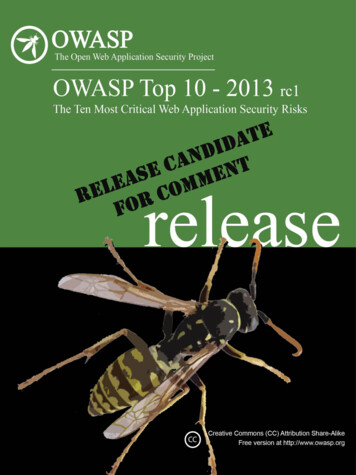

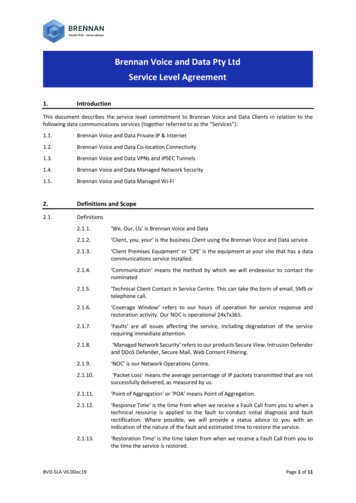
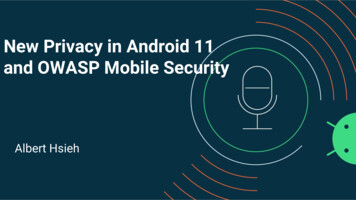



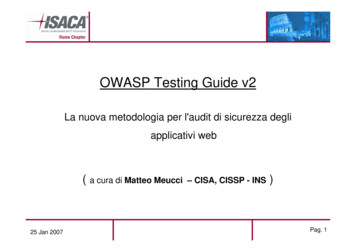
![REST API Penetration Testing Report for [CLIENT] - UnderDefense](/img/36/anonymised-api-penetration-testing-report.jpg)

